I grew up as a whitewater paddler, and some years ago paddled a whitewater kayak to a little island in the Baltic Sea. The boat was quite capable in rough water with high waves, but far from ideal for paddling long distances while carrying a load of camp-cruising supplies. After that trip I knew I needed a different kayak for cruising.
It took some years to take that step, but just as I was beginning to build boats with plywood and epoxy, we were locked down by COVID-19 and I decided to use the time to build a pair of kayaks for my wife and myself. I wanted to have safe, light, maneuverable kayaks that were still fast and could carry enough gear for longer trips. They should be uncomplicated to use and store, and meet my wife’s beginner abilities as well as my own. Paddling should be fun in the tranquil lakes and rivers near our home, as well as on rough coastal waters.
Finding a design that met all these criteria seemed almost impossible, but then I read about the Petrel Play designed by Nick Schade of Guillemot Kayaks. It was described as “a compact kayak designed for exploring rivers, lakes, and harbors, and playing in races, rips and surf.” It was shorter and wider than a typical modern sea kayak, and while designed for playing in the surf, it was also well suited to making short coastal cruises.
The Petrel Play SG is the stitch-and-glue plywood version of Guillemot’s strip-planked Petrel Play. The plans I ordered for it included 11 printed drawings, 24″ × 36″, which included full-sized patterns for all the plywood parts as well as the four female molds for the hull and the four for the deck. The 198-page manual, produced by Chesapeake Light Craft, is well illustrated with drawings and color photos and provides step-by-step instructions.
 Sebastian Schröder
Sebastian SchröderThe Petrel Play SG hull, with all its plywood panels stitched, is ready to have its seams epoxied. The cradles, seen here sitting atop the hull, will support it and help to maintain the kayak’s shape when it is flipped for the interior and deck construction.
The manual was easy to follow, and the plans showed how all the parts should be arranged to be cut from the sheets of 3mm and 4mm plywood. The very thorough instructions gave me the confidence that I’d be able to complete two Petrel Plays as my first kayak building project. It took me four months to finish both boats. I built them simultaneously, doing each step twice, which seemed to be the most effective way.
The finished kayaks, with deck lines, seat, and foot braces, each weigh 38.6 lbs, which I find very easy to carry and to load on a car roof rack, especially when I compare them to the polyethylene kayaks I’m used to, which weigh almost twice as much.
The thigh braces are specified in the plans as an option. They are flanges incorporated in the base of the cockpit coaming. I added minicell-foam pads shaped to fit me, providing very good control of the boat. On my 500-yard solo walk to the nearby lake the edges of the thigh-brace flanges do not rest on my shoulder and don’t cause me any discomfort; I change shoulders only one time on the way.
Once the Petrel Play is on the water, the cockpit opening is long enough for me to get into the seat first and then swing my legs on board. I am tall, almost 6′3″, and my feet are size 11-1⁄2, but there is plenty of room nonetheless beneath the foredeck for my feet, even when I’m wearing my kayaking shoes.
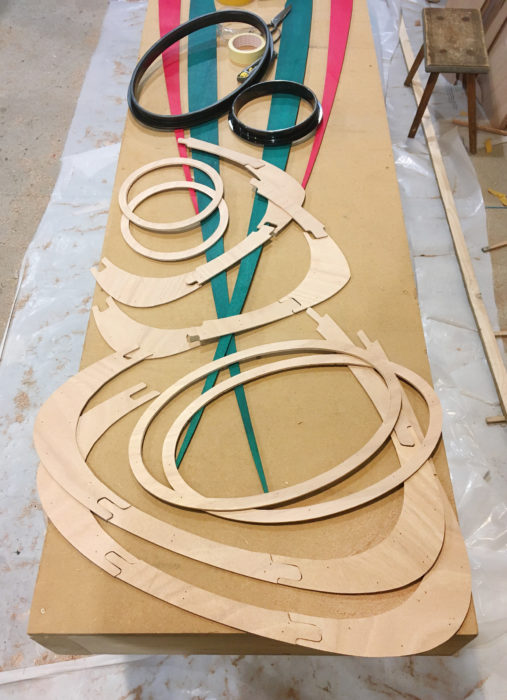 Sebastian Schröder
Sebastian SchröderThe hatch parts for both kayaks await assembly. At top are the black injection-molded coaming rings for the hatch covers—oval for the sterndeck, round for the foredeck. In the foreground are the plywood frames for the hatch recesses. Built from the plans and cut by hand, the puzzle joints seen here are not quite as tight as would be found in the machine-cut kit pieces.
The complete kit from Chesapeake Light Craft includes foot braces, a minicell seat, and a back band. I was working from plans, so I purchased Lettmann foot braces, and a back band. I custom-carved a comfortable, lightweight, and warm seat from a block of minicell foam.
The hip braces consist of a pair of plywood pieces filleted and ’glassed under the deck of the boat. Because they are not secured to the bottom, they are slightly flexible to allow movement, which is helpful for some rolling maneuvers.
The instruction manual now includes 41 pages on a retractable skeg. Those pages weren’t included in the plans I had but were available separately. Since I would have to deal with German customs—again—and wait for weeks for the transatlantic shipment of the plans, I browsed the web for solutions. It is possible to buy a ready-made skeg, build your own, or go without and thus gain more room in the compartment. I had previously made simple daggerboards for small sailing boats and so decided to forgo the skeg but create a centerboard slot instead. This would allow me to use a small daggerboard and would avoid the need to build a mechanical wooden wonder. The plans suggest offsetting the skeg from the centerline to keep sand and pebbles out of the slot, which I found a brilliant idea, and followed this for my daggerboard slot.
Making the recesses for the hatches was a challenge. Bending the tight curves with the 3mm plywood parts to their final three-dimensional shape took several tries and resulted in a few cracked pieces, but I did finally succeed. For the hatches themselves, I used standard hatch coaming rings with rubber lids. To glue the ABS hatch ring to the plywood deck, the construction manual suggests 3M’s 5200 and WEST System’s G-Flex.
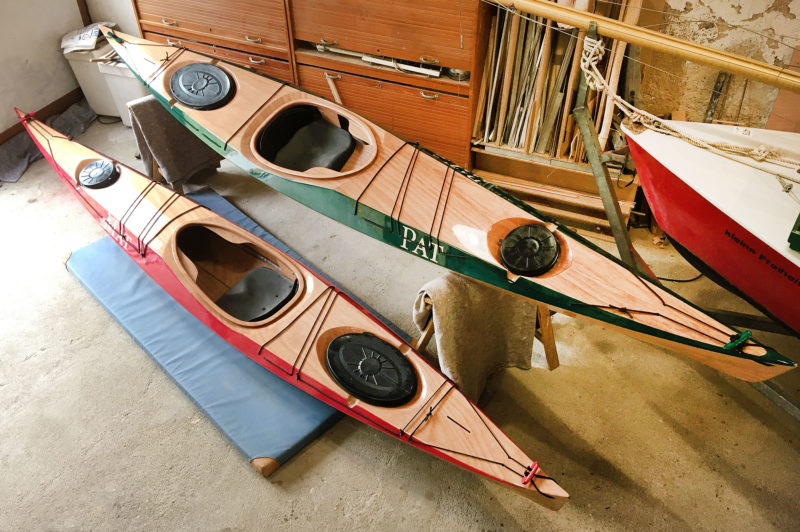 Sebastian Schröder
Sebastian SchröderEach of the two finished Petrel Play SGs weighs just under 39 lbs. The author built the boats simultaneously and, for the most part, followed the plans. His biggest departure was in replacing the retractable skegs with daggerboards—the slightly offset slots can be seen in the sterndecks.
The Petrel Play SG has two cargo compartments: a large one aft and a smaller one in the bow, where the tight opening limits the size of gear that can fit. Capacity in the aft compartment is limited by the lower deck, but despite these restrictions, the kayak offers more space than any backpack you could imagine. I felt comfortable packing for a three- to four-day trip, but for several weeks you would have to use deck space and dry bags for additional luggage.
The Petrel Play SG has a design displacement of 231 lbs, and the Chesapeake Light Craft webpage for the kayak lists the suitable paddler weight at between 100 and 220 lbs. I weigh 198 lbs and when on board, I have 2″ to 3″ of freeboard. For larger kayakers up to 350 lbs, there is the 16′ Petrel Play SGL.
When my wife, who is unfamiliar with kayaks, tried her boat for the first time, she appreciated the kayak’s good initial stability: “You finally built a boat that feels safe!” Even when she is leaning to one side, the secondary stability keeps her feeling comfortable. The good stability makes it possible for me to do chart work on a choppy sea with my hands off the paddle.
My wife also likes the Petrel Play’s good tracking: it goes where she points it. Though it excels at running straight, the kayak has excellent maneuverability. The hull’s rocker allows quick turns and even a slight edging initiates them.
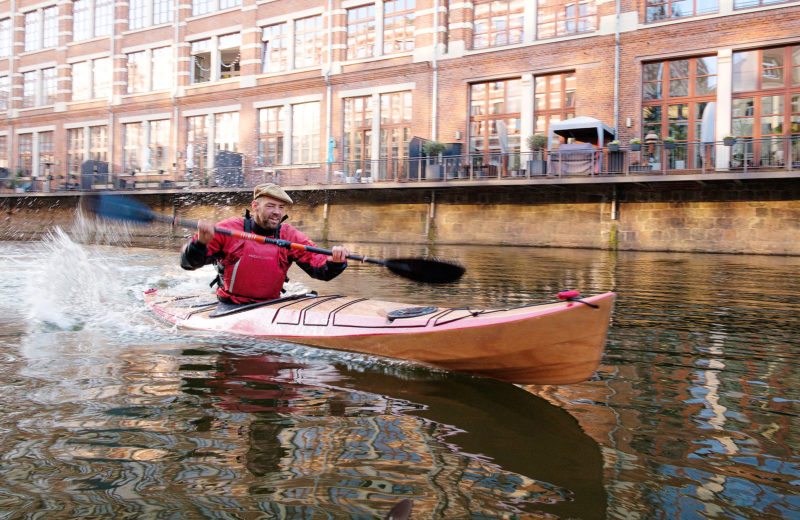 Christophe Busse
Christophe BusseWhen paddled at speed the Petrel Play’s bow lifts slightly, which the author says is beneficial in surf and only mildly detrimental when sprinting against longer racing kayaks.
With its 13′6″ waterline—shorter than that of most cruising sea kayaks—the Petrel Play SG has a lower top-end speed; its theoretical hull speed is 4.9 knots. However, I train with kayakers who have longer kayaks and, overall, the Petrel Play isn’t appreciably slower. Only when sprinting do I feel the bow rise a little and the stern go down as the longer boats pull ahead.
I like to take my Petrel Play SG out when it is really blowing to enjoy the kayak’s maneuverability and speedy surfing in the waves. At speed, the lift created at the bow is useful for playing in the surf—once I catch a wave the bow stays high, and I can feel my speed increase dramatically. When I paddle into the waves, the recessed hatches allow water to flow over the bow without creating spray and the ride is dry. When paddling into the wind, I have not needed to use the daggerboard. Even in 30 to 35 knots of wind, the Petrel Play was well balanced and didn’t weathercock to a degree that made me feel I would have to use a skeg to hold a course. For my wife, the skeg is helpful since she is not as experienced.
The Petrel Play SG is well designed for rolling. The solid foot braces and big thigh braces, combined with the fit of the hip braces and the custom-made foam seat, create a very comfortable cockpit. I feel snugly and safely locked in without having my range of motion limited. The low aft deck and the recessed coaming allow for a strong layback. From standard rolls to hand roll, the Petrel Play SG comes up with ease.
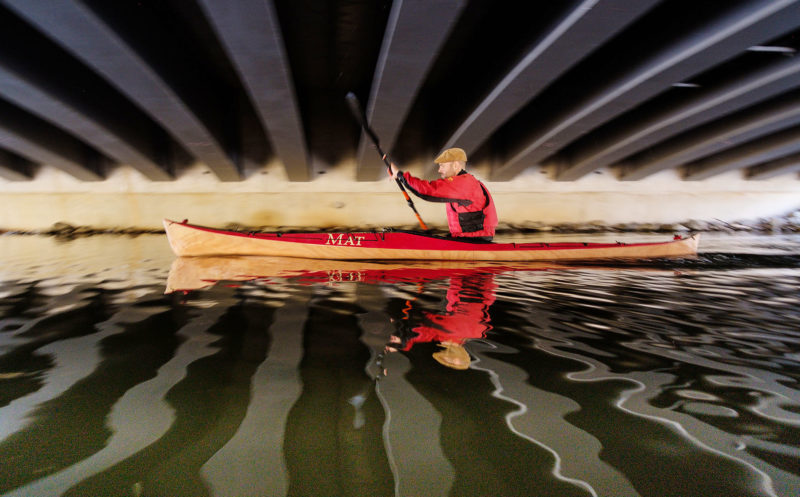 Christophe Busse
Christophe BusseShorter than conventional sea kayaks, the Petrel Play SG is designed to be as well suited to paddling coastal surf as it is for exploring urban waterways.
On a calm warm summer day, I took my empty kayak close to a beach and practiced wet exits and all types of re-entries. After a capsize, I can disengage from the thigh braces, and the cockpit opening is long enough for me to fall out effortlessly. Lifting the bow while the kayak is inverted gets the water out of the cockpit and then, once it is right-side up, it is easy to climb aboard over the low aft deck. A cowboy re-entry—straddling the stern and re-entering the cockpit feet first—works well. Of course, the boat is a little shaky before I drop into the seat, but the beam, slightly greater than that of a sea kayak, makes almost everything workable. A re-entry and roll—scooting into the cockpit while upside-down underwater before rolling up—is not one of my preferred emergency self-rescues, but it is fun and a good way to confirm that water in the boat’s cockpit does not prevent it from rolling back upright. The swamped cockpit does make the righted kayak rather tippy, and while pumping out the water it was necessary to take some bracing strokes to maintain stability. After trying all my rolling and recovery techniques, I was impressed by the Petrel Play SG.
I would enthusiastically recommend the Petrel Play SG to paddlers looking for a short, light, and maneuverable coastal kayak. It is as perfectly suited to two hours of hard exercise and training as it is to three- or four-day trips. I smile whenever there’s a stiff breeze blowing and I can look forward to getting out in my Petrel Play SG to surf a wave, snap through a turn, and drive upwind for another turn, another wave, another ride.![]()
The first kayak Sebastian Schröder learned to paddle was a polyester slalom boat. It took him from canoe slalom to whitewater and canoe polo to finally paddle sea kayaks. Living close to Leipzig in the southeast of Germany, he frequently paddles the Neuseenland where old open-pit coal mines have been flooded to create new lakes. His work as a live illustrator in creativity workshops and conferences gives him the opportunity to follow his passion: building wooden boats in traditional Scandinavian style and sailing and kayaking the Baltic Sea.
Petrel Play SG
[table]LOA/14′0″
Beam/23′
Weight/40 lbs
Max Payload/260 lbs
Paddler Weight/100–220 lbs
Cockpit size/31″ × 16″
Knee Height/12″
Max Shoe Size/12-1⁄2 U.S. Mens
[/table]
Plans for the Petrel Play SG—including nine 24″ × 36″ drawing pages plus templates for the cockpit and coaming recess parts and building notes—are available from Guillemot Kayaks, priced $129. Also available is the recommended manual: Building Strip Planked Boats, priced $22.95.
Is there a boat you’d like to know more about? Have you built one that you think other Small Boats readers would enjoy? Please email us!
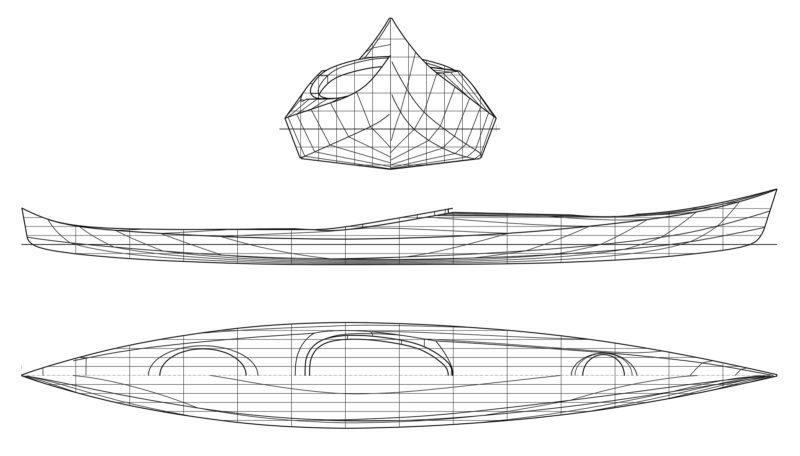


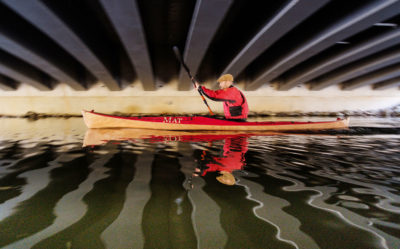

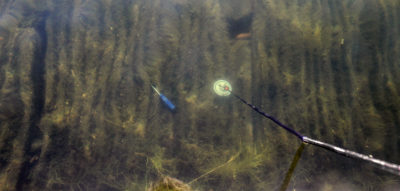
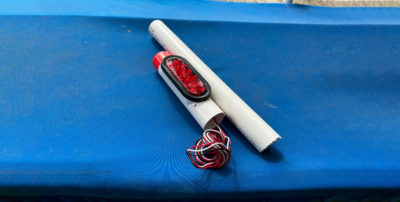
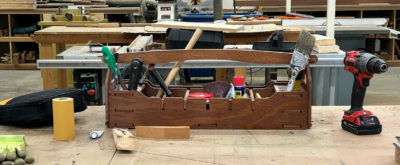

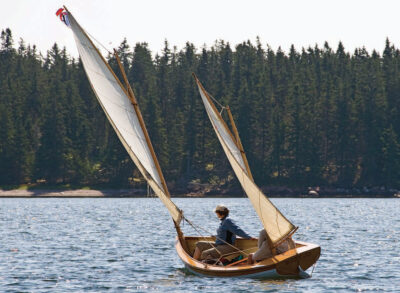


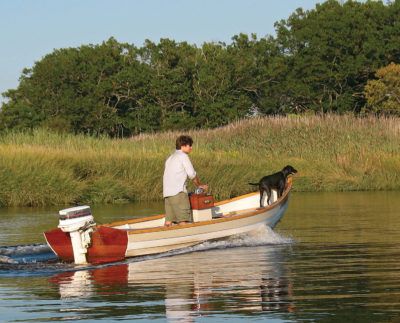
I see that CLC is still specifying copper for wiring the hull panels together. Why? Pygmy (alas, no longer with us) provided soft iron for this task, which worked very well, and was easy to remove after the initial gluing. And cheaper than copper. Does CLC still specify leaving the wire in, and taping over it? Can’t help but leave a lumpy joint, and the remaining wire adds virtually no strength.
Plywood, especially high quality 3 and 4 mil, can easily be bent with heat (no moisture needed!). If you heat bend with the long grain (grain of the surface veneer) you can bend into quite a sharp curve. I use either a heat gun for this or a little propane radiant heater I found many years ago. If you glue two of these together, as you might do for a knee or thigh brace, the resulting lamination is very stiff and strong. By using dry heat, you avoid raised grain and having to wait for the wood to dry out.
Anyhow, you did a nice job on the build, and I predict you will enjoy your boats for many years to come.
Thanks, David, for your comment. The copper wires are removed after fixation of the parts with superglue. That gives you the possibility to have a smooth surface inside the boat without wires. Using soft iron will create the same result and is cheaper. While working, I felt a 0.8 mm copper wire is nicely to handle. I used wire for coils which is coated and does not leave marks at hands, boat or tools. There are only 2 or 3 spaces where the wires can not be removed and stay in the finished boat. For bending I didn’t have to use heat but I like the way you describe bending with heat. I use a heat gun with adjustable temperature.
Hi Sebastian,
Thanks for your comprehensive review. I have just ordered my plans from CLC. I was tossing up between the Petrel Play SG and the Shearwater Sport; your review described the kayak I was after and so nudged me to the Petrel. I have a Chesapeake 17 touring kayak that I paddle my local coastline with currently, it’s a great boat but I’m looking for something to use in the surf and when there’s a ‘lumpy’ sea running. I’m looking forward to getting stuck into the build. (I think I enjoy building almost as much as I do paddling.) Great job on your kayaks, they look fantastic!
Cheers from Australia
Hi Andrew,
I hope your Petrel Play project is on going. During building the two boats I was looking for a solution of not drilling any hole into the hull and found some very interesting ways. All the lines go through a kind of laminated “tunnel” and the footrests a glued a the inside. The boat is perfectly tight. If you would like further information just contact me.
Good luck with building the boat!